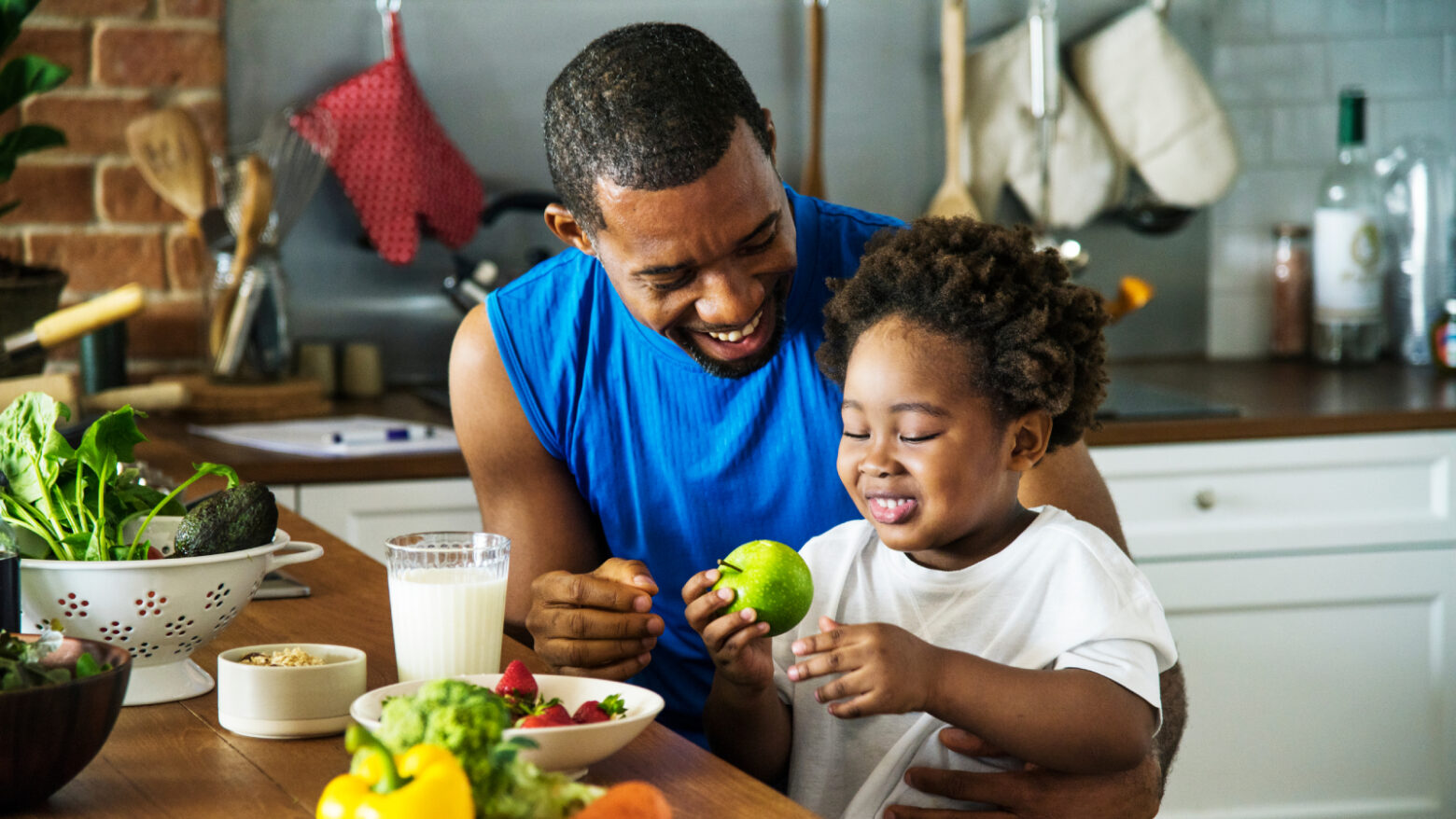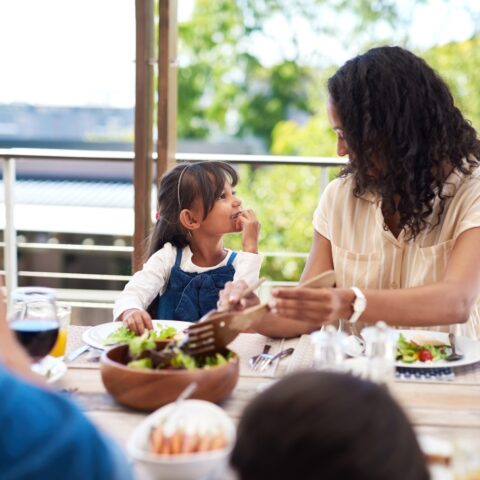How to Help Your Kids Eat Healthy

It’s not easy to keep your kids eating a variety of healthy fruits and veggies. Especially when school lunch options can be so limiting and unhealthy.
Eating unhealthy lunches for years can take a negative toll on both the mental and physical health of children. In 2012, the U.S. government updated the National School Lunch and School Breakfast Programs. Changes included counting fruits and vegetables as separate meal groups, offering fruit every day, making half of the grain choices whole grains, giving different grades different meal sizes, and reducing sodium and trans fat in meals. However, not all schools implement the NSLP and not all students eat the healthier choices schools provide.1
A third of kids and adolescents in the United States are overweight or obese2 and even if the government regulates the number of calories a child’s school lunch has, as it does with the NSLP, many schools allow children to purchase a la carte foods on top of the calorie-rich main entrée high in fat, sodium, sugar or all three.
And, these a la carte options tempt children ages 2-18 who, according to the Academy of Nutrition and Dietetics, get their calories from milk, cakes, cookies, quick bread, pastry and pie! 3 Their carbohydrates come primarily from soft drinks and rolls; their fat from cheese and from crackers, popcorn, pretzels and chips.
So rather than setting the kids up for health problems including diabetes, kidney stones, bone loss, cancer, heart disease as well as lower IQ scores, parents and kids can proactively take control of what they’re cooking and eating not just at home but to take to school as well.
It’s not just a matter of assuming that lunches brought from home are inherently healthier; in fact, quite the contrary. Lunches brought from home contained almost double the amount of sodium as government meal program lunches, 40% less fruit and 88% fewer vegetables. Additionally, 90% of packed lunches included desserts, chips or sweetened beverages, not permitted in school lunch program meals, and students almost always entirely consumed them, according to a study done at Baylor College of Medicine.4
Now, here is where being a health conscious Paleo parent becomes a crucial part of ensuring the kids are eating properly. You’re practicing mindful, conscientious sourcing, shopping and healthy, regular food preparation, and simply by doing that, you’re doing the single most important thing: leading by example for your kids. The second: get the kids involved right away; the more they contribute, the more likely they are to be inclined to eat what they’ve prepared.
Researchers at Teachers College at Columbia University5 studied how cooking with a child affects the child’s eating habits and found that children who had cooked their own foods were more likely to eat those foods in the cafeteria, and even ask for seconds, than children who had not had the cooking class. When children are involved in meal preparation, “they come to at least try the food,” said Isobel Contento, professor of nutrition education at Teachers College and a co-author of the study.
Keeping foods looking, tasting, and smelling delicious is the key to preventing boredom, and it demonstrates that healthy food can be both tasty and satiating, not one or the other.
Got picky kids?
For children with a “particular” palate, try the theory of repetition. Susan B. Roberts, a Tufts University nutritionist and author6 suggests a “rule of 15” which involves putting a food on the table at least 15 times to see if a child will accept it. Once a food is accepted, parents should use “food bridges” (similarly colored or flavored foods) to expand the variety of foods a child will eat. If a child likes pumpkin pie, for instance, try mashed sweet potatoes and then mashed carrots.
Feeling like you’re not going to be able to find all the time needed to teach the kids about properly sourcing meat, choosing the best in-season veggies, and how to cook economically? Think about how much time the family is spending on other group activities, such as watching television or even sitting around on smartphones or tablets.
A study by Common Sense Media7 found kids ages 0-8 spend an average of two hours a day with screen media like smartphones, video games, computers, television, and DVDs. And adults aged 35-49 watch more than 33 hours of television per week, according to data from Nielsen.8
Looks to me like there is quite a bit of wiggle room right there! Why not reallocate those precious hours to spending time as a family gardening, cooking, and enjoying meals both at home, as well as sent to the school lunchroom with love. Don’t be surprised if other parents begin to reach out to get your two cents on how on earth you got the little ones to eat broccoli and grilled chicken for lunch with gusto!
References
[1] Schuna, Carly. The Effects of Children Eating Unhealthy School Lunches | Livestrong.com [Internet]. LIVESTRONG.COM. 2011. Available from: https://www.livestrong.com/article/351827-the-effects-of-children-eating-unhealthy-school-lunches/
[2] National Institute of Diabetes and Digestive and Kidney Diseases. Weight Management | NIDDK [Internet]. National Institute of Diabetes and Digestive and Kidney Diseases. 2019. Available from: https://www.niddk.nih.gov/health-information/weight-management
[3] Ogata BN, Hayes D. Position of the Academy of Nutrition and Dietetics: Nutrition Guidance for Healthy Children Ages 2 to 11 Years. Journal of the Academy of Nutrition and Dietetics. 2014 Aug;114(8):1257–76.
[4] Brown Bag or Cafeteria Tray, Kids Don’t Eat Healthy School Lunch. Bloomberg.com [Internet]. 2014 Nov 24 [cited 2023 Aug 11]; Available from: https://www.bloomberg.com/news/articles/2014-11-24/yuck-students-not-eating-nutrition-program-s-healthy-lunches
[5] 6 Food Mistakes Parents Make. The New York Times [Internet]. 2008 Sep 14; Available from: https://www.nytimes.com/2008/09/15/health/healthspecial2/15eat.html
[6] Roberts SB, Heyman MB, Tracy L. Feeding Your Child for Lifelong Health: Birth Through Age Six. New York: Bantam Books; 1999.
[7] The Reality Of Kids And Screen Time [Internet]. HuffPost. 2011 [cited 2023 Aug 11]. Available from: https://www.huffpost.com/entry/kids-and-technology-how-m_n_1031231
[8] Americans spend 34 hours a week watching TV, according to Nielsen numbers [Internet]. New York Daily News. 2012 [cited 2023 Aug 11]. Available from: https://www.nydailynews.com/entertainment/tv-movies/americans-spend-34-hours-week-watching-tv-nielsen-numbers-article-1.1162285
Nell Stephenson, B.S.
Nell Stephenson has been an advocate for The Paleo Diet since 2011, and is the co-author of The Paleo Diet Cookbook.
More About The Author




